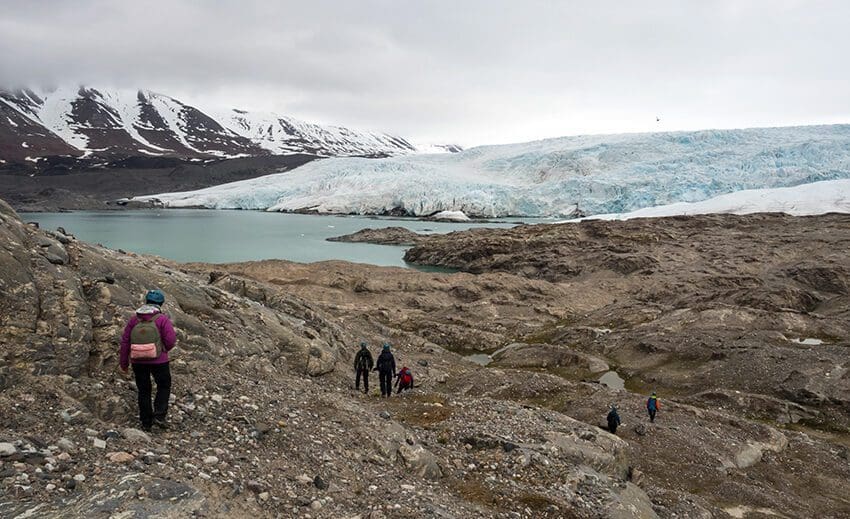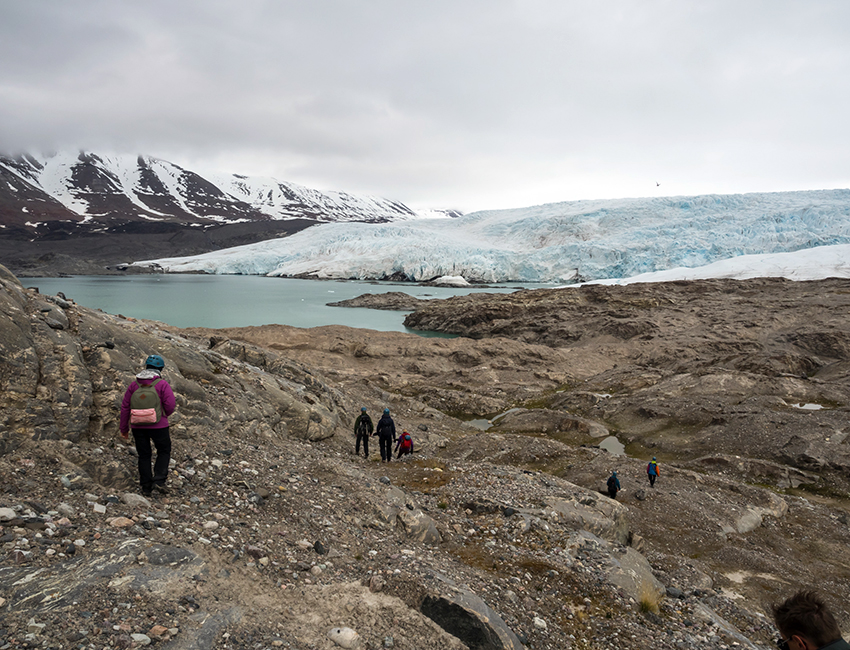AS-302 Safety Management in the Arctic (10 ECTS)
ID:
AS-302
CREDITS:
10 ECTS
APPLICATION DEADLINE:
April 15, 2024
START DATE:
August 05, 2024
END DATE:
September 19, 2024
COURSE PERIOD:
Autumn semester (Block 5)

AS-301 on Nordenskiöldbreen June 2018. Photo: Thorben Dunse/UNIS
| Grade: | Letter grade (A through F) |
| Course Cost: | None |
| Course Capacity Min/Max: | 15/30 students |
| Language of instruction: | English |
| Examination support material: | Bilingual dictionary between English and mother tongue |
Course requirements
Enrolment in a relevant master programme in social-, technological- or natural sciences.
Academic content
The main focus of the course is prevention of accidents and unwanted occurrences that may lead to loss of life in the Arctic. The course demonstrates how systematic work with loss prevention should be performed in organizations operating in the Arctic, i.e. by generating knowledge to support decisions about mitigating measures. In addition, the course provides knowledge about the theoretical foundations for systematic safety management in the Arctic.
The course content can be categorized into four modules:
- Safety management in the Arctic: theories, models and framework conditions:
- principles for experience feedback and learning from unwanted occurrences
- accident models and accident analysis framework
- decision-making processes and constrains
- risk influencing factors in the Arctic
- Human performance in the operative context of the Arctic. Challenging operational conditions, in particular harsh weather conditions, in the Arctic impact human performance and increase accident risk for any activities. Thus, safe and reliable operations in the Arctic requires an understanding of both human performance in these conditions as well as of the organizational and environmental Arctic context. Topics included in the module are:
- Arctic operational conditions
- Psychological safety
- Situation awareness
- Human factors methods: task analysis and human error identification
- Organizational safety theories relevant for the understanding of human performance
- Human error
- Methods and tools for control of hazards in the Arctic: application, principles, limits and merits:
- hazard identification
- risk assessments: strategic and operative
- incident investigation
- reporting of unwanted occurrences
- Mitigating occupational accident risk in the Arctic:
- choose and assess efficient preventive measures and argue for the choice of these
- barriers against loss
- deviation handling
- influencing the human factor
- Practical management of Arctic safety:
- planning and execution of field trip safety
- practical handling of Arctic safety
Learning outcomes
The course will provide students with knowledge, skills and competence in designing and running safety management systems in an Arctic context. The students will gain knowledge about theoretical principles and models that is the foundation for safety management in organizations. After the course, students will be able to apply different methods and tools for generation of knowledge about past, current and future safety performance for activities and systems in the Arctic. Based on the theoretical foundations and the methods and tools, the students shall be able to suggest adequate safety measures to control Arctic hazards. The combination of practical knowledge about Arctic operations and Arctic hazards and theoretical understanding of safety management is emphasized in the course.
Upon completing the course, the students will be able to:
Knowledge
- explain the theoretical foundation for different methods and tools used to identify, analyze and evaluate accident risks and remedial actions
- explain the principles for experience feedback and learning from unwanted occurrences
- explain how different knowledge sources are systematically combined into decision-making support
- identify hazards in Arctic environments
- explain risk influencing factors and framework conditions for management of safety in an Arctic context
- choose and assess appropriate methods and tools for a systematic and efficient accident prevention work in an Arctic context
- categorize different perspectives on safety theories on organizational accidents
- recognize factors influencing human performance in the Arctic
- explain human errors and how they can occur
- understand team processes and psychological safety in teams
- understand how mindful organizing provide skills for managing the unexpected
- explain situation awareness in teams
Skills
- assess risk for different tasks and systems in the Arctic
- apply methods for accident investigation at different levels
- apply methods for reporting of unwanted occurrences
- apply methods for measurement of safety performance
- reflect critically on how human factors affect decision making
- assess distributed situational awareness in teams
- build psychological safety in teams
- conduct human factors methods including task analysis and human error identification
- hold an oral presentation regarding relevant issues of safety management in the Arctic
General competences
- solve practical tasks in operational safety management in the Arctic
- understand how climate change in the Arctic affect societal safety
Learning activities
The course extends over 6 weeks including compulsory safety training, and is run in combination with AS-802.
- Compulsory safety training, extended version including explanations on the design of the UNIS safety training program.
- Lectures with examples from the Arctic to support both theories and models as well as application of methods and tools.
- Exercises containing application of methods and tools on Arctic cases.
- Guest lectures by representatives from companies operating in Longyearbyen.
- Plan safety for a field trip for UNIS students
Summary
- Total lecture hours: 72 hours
- Total seminar hours: 23 hours
- Total exercise hours: 20 hours
- Fieldwork: TBA
- Excursions: TBA
Compulsory learning activities
- A number of exercises (application of methods and tools)
- Presentations and participation at student presentations
All compulsory learning activities must be approved in order to sit the exam.
Assessment
| Method | Percentage of final grade |
| Group report | 20% |
| Group report | 20% |
| Oral exam – presentations | 60% |
All assessments must be passed in order to pass the course.
Each assessment is graded, and subsequently combined into a single grade. Partial grades for each assessment will be available.

